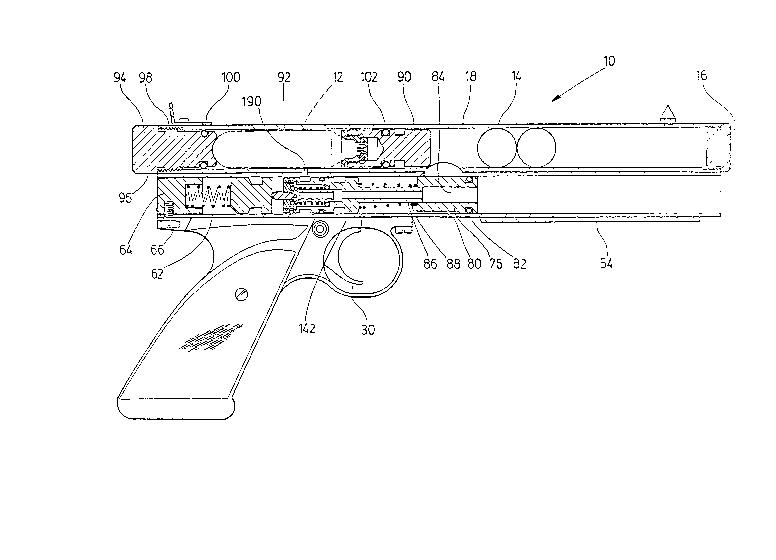Some of the information on this Web page has been provided by external sources. The Government of Canada is not responsible for the accuracy, reliability or currency of the information supplied by external sources. Users wishing to rely upon this information should consult directly with the source of the information. Content provided by external sources is not subject to official languages, privacy and accessibility requirements.
Any discrepancies in the text and image of the Claims and Abstract are due to differing posting times. Text of the Claims and Abstract are posted:
| (12) Patent: | (11) CA 1264128 |
|---|---|
| (21) Application Number: | 1264128 |
| (54) English Title: | AIR GUN |
| (54) French Title: | FUSIL A AIR |
| Status: | Term Expired - Post Grant |
| (51) International Patent Classification (IPC): |
|
|---|---|
| (72) Inventors : |
|
| (73) Owners : |
|
| (71) Applicants : |
|
| (74) Agent: | SMART & BIGGAR LP |
| (74) Associate agent: | |
| (45) Issued: | 1990-01-02 |
| (22) Filed Date: | 1988-09-29 |
| Availability of licence: | N/A |
| Dedicated to the Public: | N/A |
| (25) Language of filing: | English |
| Patent Cooperation Treaty (PCT): | No |
|---|
| (30) Application Priority Data: | None |
|---|
ABSTRACT
A gun for firing pellets such as paint pellets
has a lower barrel through which the pellets are
fired and a hammer mechanism mounted in a rear end
portion of this barrel. This mechanism includes a
hammer spring and a hammer. An upper barrel is
mounted on the lower one and it contains means for
holding and punching a hole in a gas cylinder mounted
in this upper barrel. A gas valve system is arranged
in the lower barrel in front of the hammer. This
system has a valve body fixedly located in the lower
barrel, which body has a gas chamber and a forward
gas passageway that is connected to the chamber when
the gun is fired. A hole extends between the two
barrels and is located along a portion of the upper
barrel that holds the gas cyclinder. There are means
for releasing compressed gas from the gas chamber and
through the forward gas passageway to fire a pellet
when the hammer is released.
Note: Claims are shown in the official language in which they were submitted.
Note: Descriptions are shown in the official language in which they were submitted.

2024-08-01:As part of the Next Generation Patents (NGP) transition, the Canadian Patents Database (CPD) now contains a more detailed Event History, which replicates the Event Log of our new back-office solution.
Please note that "Inactive:" events refers to events no longer in use in our new back-office solution.
For a clearer understanding of the status of the application/patent presented on this page, the site Disclaimer , as well as the definitions for Patent , Event History , Maintenance Fee and Payment History should be consulted.
| Description | Date |
|---|---|
| Inactive: IPC deactivated | 2016-01-16 |
| Inactive: IPC deactivated | 2016-01-16 |
| Inactive: IPC assigned | 2015-12-21 |
| Inactive: IPC assigned | 2015-12-21 |
| Inactive: First IPC assigned | 2015-12-21 |
| Inactive: IPC expired | 2013-01-01 |
| Inactive: IPC expired | 2013-01-01 |
| Inactive: Expired (old Act Patent) latest possible expiry date | 2008-09-29 |
| Inactive: Office letter | 2007-01-12 |
| Inactive: IPC from MCD | 2006-03-11 |
| Grant by Issuance | 1990-01-02 |
There is no abandonment history.
| Fee Type | Anniversary Year | Due Date | Paid Date |
|---|---|---|---|
| MF (category 1, 8th anniv.) - standard | 1998-01-02 | 1998-01-02 | |
| MF (category 1, 9th anniv.) - standard | 1999-01-04 | 1998-12-16 | |
| MF (category 1, 10th anniv.) - standard | 2000-01-04 | 1999-12-31 | |
| MF (category 1, 11th anniv.) - standard | 2001-01-02 | 2000-12-19 | |
| MF (category 1, 12th anniv.) - standard | 2002-01-02 | 2001-12-19 | |
| MF (category 1, 13th anniv.) - standard | 2003-01-02 | 2003-01-02 | |
| MF (category 1, 14th anniv.) - standard | 2004-01-02 | 2003-12-30 | |
| MF (category 1, 15th anniv.) - standard | 2005-01-04 | 2004-12-31 | |
| MF (category 1, 16th anniv.) - standard | 2006-01-03 | 2005-12-28 | |
| 2006-12-28 |
Note: Records showing the ownership history in alphabetical order.
| Current Owners on Record |
|---|
| BRASS EAGLE INC. |
| Past Owners on Record |
|---|
| ALDO PERRONE |